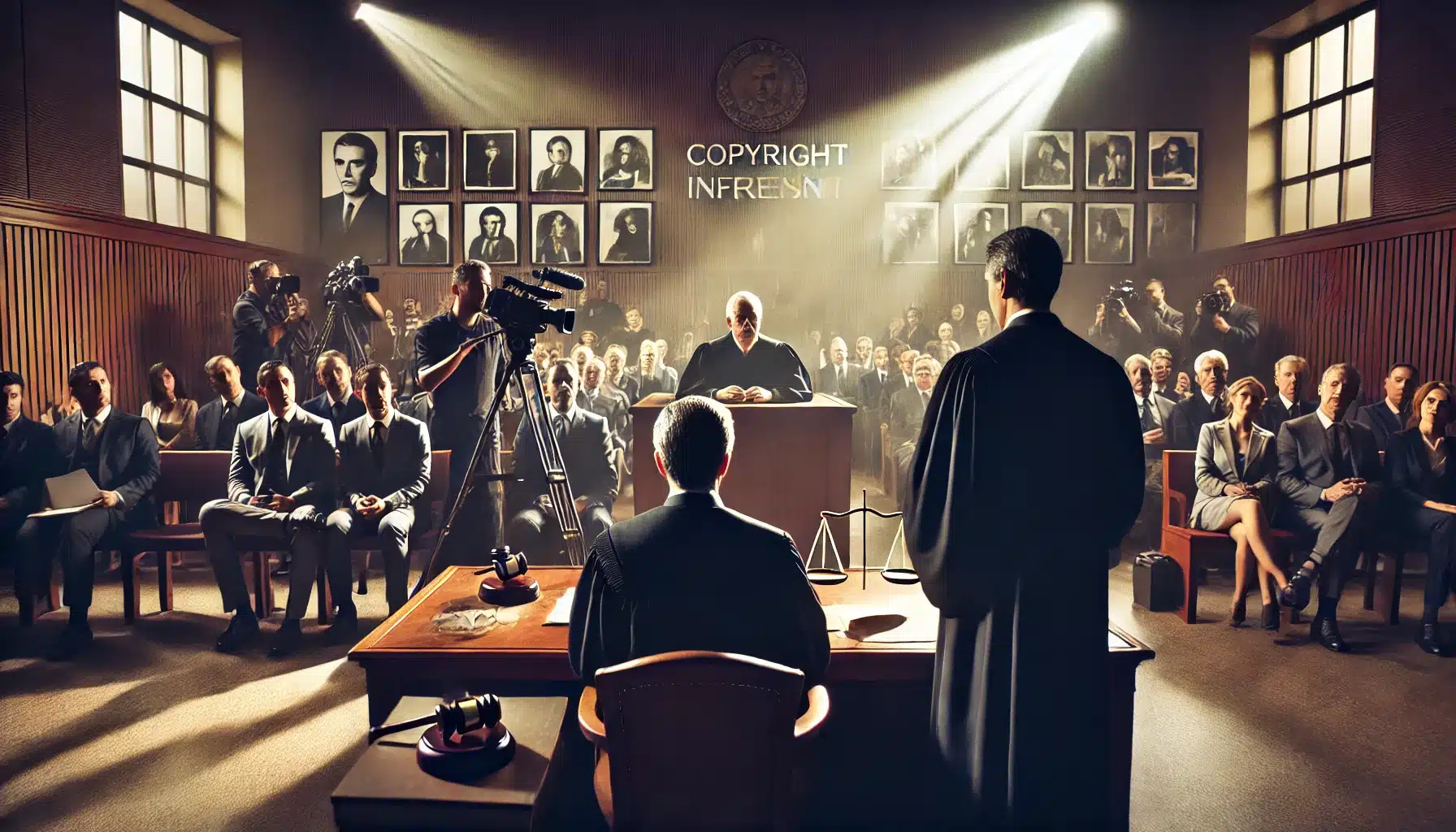The Calcutta High Court, in Shree Venkatesh Films Pvt. Ltd v. Vipul Amrutlal Shah & Ors (2009), addressed copyright infringement concerning the Bengali film “Poran Jaye Joliya Rae” and the Hindi film “Namastey London.” The court found substantial similarity between the two films, determining that th

“If the work is a literal imitation of the original work, with only minor variations, it constitutes a copyright violation. For infringement to be actionable, the copied portion must be substantial and material. Minor or insubstantial copying does not meet the threshold for copyright infringement.”
Citation: AIR 2010 (NOC) 610 (CAL.)
Date of Judgement: 1st September, 2009
Court: High Court of Calcutta
Bench: Pinaki Chandra Ghose (J)
Facts
- This appeal involves a dispute over an interim injunction granted in a copyright infringement case concerning the Bengali film “Poran Jaye Joliya Rae” and the Hindi film “Namastey London.” The injunction, issued by the lower court, ordered the cessation of the Bengali film’s exhibition based on allegations of copyright infringement.
- The Hindi film “Namastey London” was a major success, earning over Rs. 100 crores at the box office. The film’s storyline involves a conservative Indian family in Britain, their British-cultured daughter, and her journey from rejecting to embracing her Indian marriage.
- Prior to the release of “Poran Jaye Joliya Rae” on July 24, 2009, media reviews suggested that the Bengali film was essentially a copy of “Namastey London.” Despite this, the plaintiff did not file a lawsuit until after the Bengali film’s release, which led the court to suspect that the plaintiff waited to see the Bengali film’s success before acting.
- The plaintiff filed the suit ten days after the release of the Bengali film, leading the lower court to issue an interim injunction to stop the film’s exhibition.
- The appellants, which include the film’s producer and director, challenged this injunction, arguing that the lower court’s decision was based on insufficient evidence of copyright infringement.
- The appellants contended that the Bengali film was an original work with distinct scenes that made it a separate entity from “Namastey London.” They also argued that even if the films shared similarities, this did not constitute copyright infringement since copyright law protects against copying, not against borrowing themes or ideas.
- The appellants argued that the lower court’s finding of “plagiarism” rather than “infringement of copyright” was contradictory. They also challenged the court’s decision to view the film as part of its deliberation, citing legal precedents that suggest a narrow interpretation of the term “copy” in the context of cinematographic works.
- The respondents claimed copyright in the story and screenplay of “Namastey London” and argued that as the employer of the writers, they held the first copyright over the work under Section 17(a) and (c) of the Copyright Act.
Decision of the High Court of Calcutta
In the case at hand, the central issue before the court was whether there was a violation of copyright due to substantial similarity between two works. The court’s decision was primarily guided by the principles laid down in previous legal precedents and statutory provisions related to copyright infringement.
The court held that to determine if a copyright violation occurred, it is crucial to assess whether the similarities between the works are fundamental or substantial. If the defendant’s work is essentially a literal imitation of the copyrighted work with minor variations, it constitutes a copyright violation. The court emphasized that “In order to be actionable, the copy must be a substantial and material one which at once leads to the conclusion that the defendant is guilty of an act of piracy.”
The court referenced the principle in the judgment that “One of the surest and safest tests to determine whether or not there has been a violation of copyright is to see if the reader, spectator, or viewer after having read or seen both the works is clearly of the opinion and gets an unmistakable impression that the subsequent work appears to be a copy of the original.”
This was supported by the case law where courts have noted that if the theme is similar but presented differently, resulting in a completely new work, copyright infringement does not arise. Conversely, if there are material and broad dissimilarities, indicating that the similarities are incidental, no infringement occurs.
The court also cited the Division Bench decision of the Bombay High Court in Zee Telefilms Limited & Anr. v. Sundial Communication Pvt. Ltd. & Ors.[1], which reinforced the need for a substantial similarity test. Additionally, it referred to the Delhi High Court decision in Mirabai Films Pvt. Ltd. v. Siti Cable Network & Ors.[2], noting that appellate courts generally do not interfere with trial court discretion unless clear errors are demonstrated.
Further, the court relied on the Supreme Court judgment in Indian Performing Right Society Ltd. v. Eastern India Motion Picture Association & Ors.[3] to underscore that a film, being a composite work of various elements like story, screenplay, and dialogue, has copyright protection. The producer’s rights extend to the entire film, even though individual components may have their own copyrights.
The court conducted a detailed scene-by-scene comparison of the films and found that the Bengali film was substantially similar to the Hindi film. This finding suggested possible copyright infringement, as the total impression of copying was evident. The court recognized that while films are complex works, substantial copying could be established if the overall impression was that of a copy.
Regarding interim relief, the court upheld the ad interim order, which was deemed appropriate to protect the plaintiff’s rights while considering the interests of third parties, such as distributors. The order was tailored to balance these interests by limiting further distribution and adaptation while addressing the financial and distribution rights of third parties.
The court affirmed the interim order, which included directives for the collection of box office revenues and protection of rights until the case’s resolution. It acknowledged the need to extend deadlines for filing affidavits and responses, emphasizing that its observations were preliminary and would not affect the final trial court decision. The judgment underscored the importance of substantial similarity in copyright infringement cases and balanced protecting original works against the rights of third parties.
Key legal issues discussed
1. Whether the appellant/defendant has infringed the respondents/plaintiff’s Copyright by copying their work for making a cinematographic film?
Yes
The appellant/defendant has infringed the respondent/plaintiff’s copyright by copying their work to make a cinematographic film. The court’s reasoning is based on the fact that, upon comparing both works, there was a substantial and prima facie similarity that led to the conclusion that the subsequent film was, in essence, a copy of the original. The court emphasized that, even though copyright infringement does not require an exact replica, the broad similarities observed, coupled with the substantial innovation in the original work, indicate that the defendant’s film could be seen as a derivative of the plaintiff’s work. The court further supported its finding by referring to established legal principles which hold that substantial similarity and the impression left on an ordinary viewer are key indicators of copyright infringement, and thus, the plaintiff’s claim was deemed credible based on these tests.
2. Did the court find substantial similarity between the works?
Yes
The court determined that the Bengali film was substantially similar to the Hindi film. This conclusion was reached after a detailed scene-by-scene comparison of the two films, which revealed significant similarities in their overall presentation.
The court’s finding aligns with the legal principle that a substantial and material replication of a copyrighted work, even with minor variations, constitutes copyright infringement. This principle is reinforced by various precedents where the degree of similarity in the mode of expression is crucial to determine infringement. As established, if the defendant’s work merely varies slightly from the original while replicating fundamental aspects, it amounts to copyright infringement. This broad interpretation ensures that any substantial copying leading to piracy is actionable.
3. Did the court address the balance between protecting the plaintiff’s rights and the rights of third parties involved?
Yes
The court considered the need to balance the plaintiff’s rights with the rights of third parties, such as distributors, and modified the injunction to address these concerns.
The court’s approach is consistent with the principle that copyright enforcement should not unduly harm third parties. The modification of the injunction to accommodate distributor rights reflects a balanced judicial approach that protects copyright while mitigating the impact on third-party interests.
[1] (2003) 2 CTMR 16 (Bom.) (DB).
[2] (2003) 26 PTC 473 (Del) (DB).
[3] AIR 1977 SC 1443.


